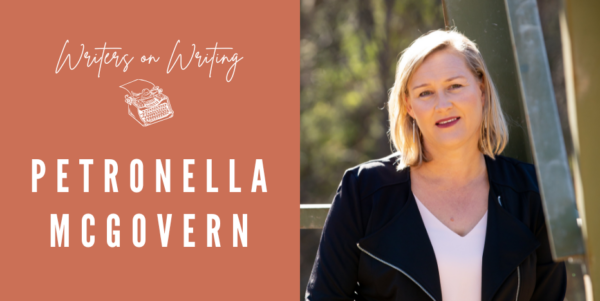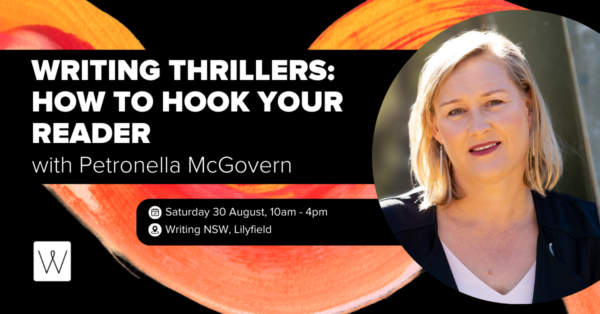
Writers on Writing is our regular conversation with a writer or industry professional about the writing craft, industry insights, and their own practice. This week, we spoke to Petronella McGovern about writing thrillers that shock and excite readers, and how to let your story surprise you.
What is the process for writing twisty and unexpected thrillers?
Some thriller authors plot their storylines from the beginning and plan every twist, whereas others (like me) write their way into the story and discover the twists as they’re going, just like the reader does. Whichever way you work, the important factor is making sure your reader is invested in the storyline and gasping at the effect of your twists on your characters. It’s not enough to simply have a clever twist — you need a well-developed cast of characters (protagonists and antagonists) who have internal motivations and individual histories, and they act according to those in their own unique way. We don’t want stereotypes who have predictable reactions to events.
When you’re writing a twist or climax, it’s useful to ask yourself a few questions: Does this fit within the logic of my story? What makes my character behave like this? How will my characters react to this? What will the outcome mean for them? And of course, always consider– is there a better option for the twist? You can brainstorm different ideas and see which feel best for the story and points it in the direction you need.
There seems to be an abundance of thrillers on the market. How can a writer make theirs stand out?
When a reader gets to the end of a thriller, unfortunately they don’t always remember the complicated plot, subplots and twists which the author laboured over for years! They usually recall the characters and the settings, and how the book made them feel. So to make a thriller stand out, concentrate on creating interesting characters and settings that add extra layers to your story.
Having said that, if there’s one major twist which absolutely shocks readers, they’ll talk about it with their friends, and recommend the book. I also love an unreliable narrator who turns a story on its head.
The thriller genre is broad and developing new trends all the time. For example, using the villain’s point of view; a technological or medical angle; hot button topics like climate change and gendered violence; voices from beyond the grave; and challenging traditional tropes. In my most recent family thriller, The Last Trace, I incorporate how we’re using new DNA technology within both families and criminal investigations, along with a character who is a water engineer working in drought-stricken areas.
What does your daily writing practice look like?
My creative brain is best early in the morning before I look at emails or social media. When I go to bed thinking about the story, my subconscious works overnight so that when I wake up and open my laptop, the ideas will flow. When I do an hour of early writing, that sets me up to keep coming back to the story throughout the day between other work.
I’ve just been on a writing retreat and I love having that total immersion in the story for a few days straight. When I was writing The Last Trace, I serendipitously went on a retreat to Cooma in the NSW Snowy Mountains near where the story is set. It was inspiring to be inside the landscape and feel the sights, sounds, smells and colours which I could write into the story.
When I begin writing a book, I don’t have an outline but I usually know the twist. I love the surprise of where the story takes me. And then when I’m re-writing and editing, I really strengthen the red herrings, twists and unexpected turns of the storyline.
What are some of your tips for creating characters that readers care about? And is it possible to care about villains?
Let the reader see your character’s innermost thoughts, their deepest desires (good and bad!), their wildest dreams and their darkest fears. Show us what’s most important to them in this story world – a partner, child, dog, money, respect, reputation, health, religion, beauty. And then make things extra hard for your character and show us their vulnerabilities. All of that will make us care what happens to them.
Depending on the type of story, we can either hate a villain or cheer them on. The most interesting villains have a reason for their evil behaviour. We’ll care about them if we can understand their ‘why’. As Stephen King said, “Even bad guys (most of them, anyway) see themselves as good—they are the heroes of their own lives. Giving them a fair chance as characters can create some interesting shades of grey—and shades of grey are also a part of life.”
How can playing with pace improve our thrillers?
Readers want a thriller they can’t put down, a reading experience that mirrors the excitement on the page. Cliff hangers can be used as mini-climaxes throughout the story, as well as at the end of each chapter to keep us turning the pages. A ticking clock adds another level of tension to the pace.
But it can’t be relentless, all at one speed, throughout the whole book. We have to allow some quieter times for setting up a situation and to give the reader time to process what’s happening. Varying the length of both sentences and chapters helps to ramp the pace up or down. In the quieter chapters, you can still increase the build-up of tension. It’s a delicate balance, ebbing and flowing, until the last third which races towards the exciting end.
Petronella McGovern is fascinated by what makes us tick, the lies we tell, and the secrets we keep. She is the best-selling author of Six Minutes, The Good Teacher, The Liars and The Last Trace. Her books have been nominated in the Ned Kelly Awards, the Davitt Awards and the Australian Independent Bookseller Awards. The Liars was selected in the Top 100 Big W/Better Reading list for 2023. Petronella has a Master of Arts in Creative Writing and tutors in creative writing. She grew up on a farm in central west NSW and now lives with her family in Sydney on Gadigal Country. Among other adventures, she has worked on a summer camp in America and travelled in eastern Africa which inspired parts of her fourth novel, The Last Trace.
Join Petronella McGovern for her course, Writing Thrillers: How To Hook Your Reader, Saturday 30 August 2025, 10am – 4pm.

If you want to be the first to read great advice, prompts and inspiration from our incredible tutors, subscribe to our weekly e-newsletter Newsbite.
More from Writing NSW
Check out our full range of writing courses in Sydney, our online writing courses and our feedback programs to see how we can help you on your creative writing journey. Find out about our grants and prizes, as well as writing groups across NSW, and sign up to our weekly newsletter for writing events, opportunities and giveaways.
